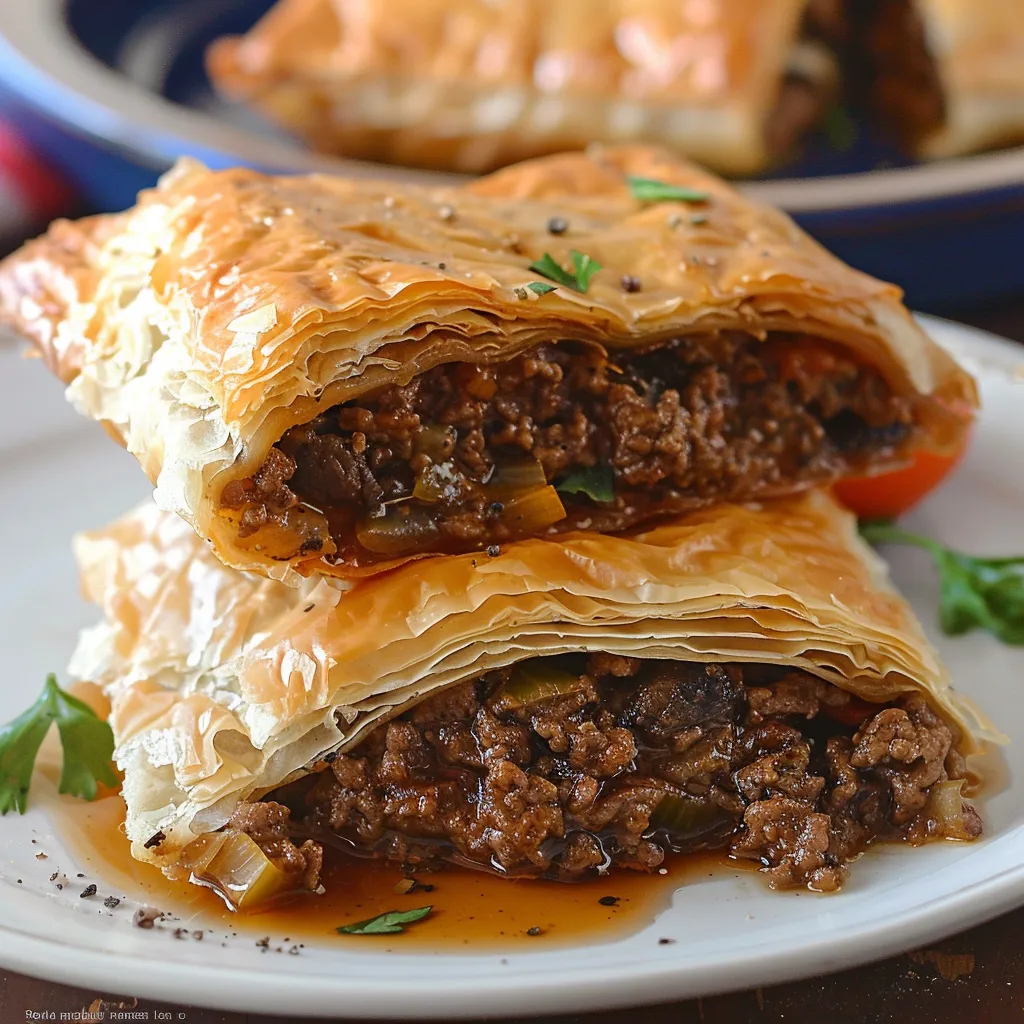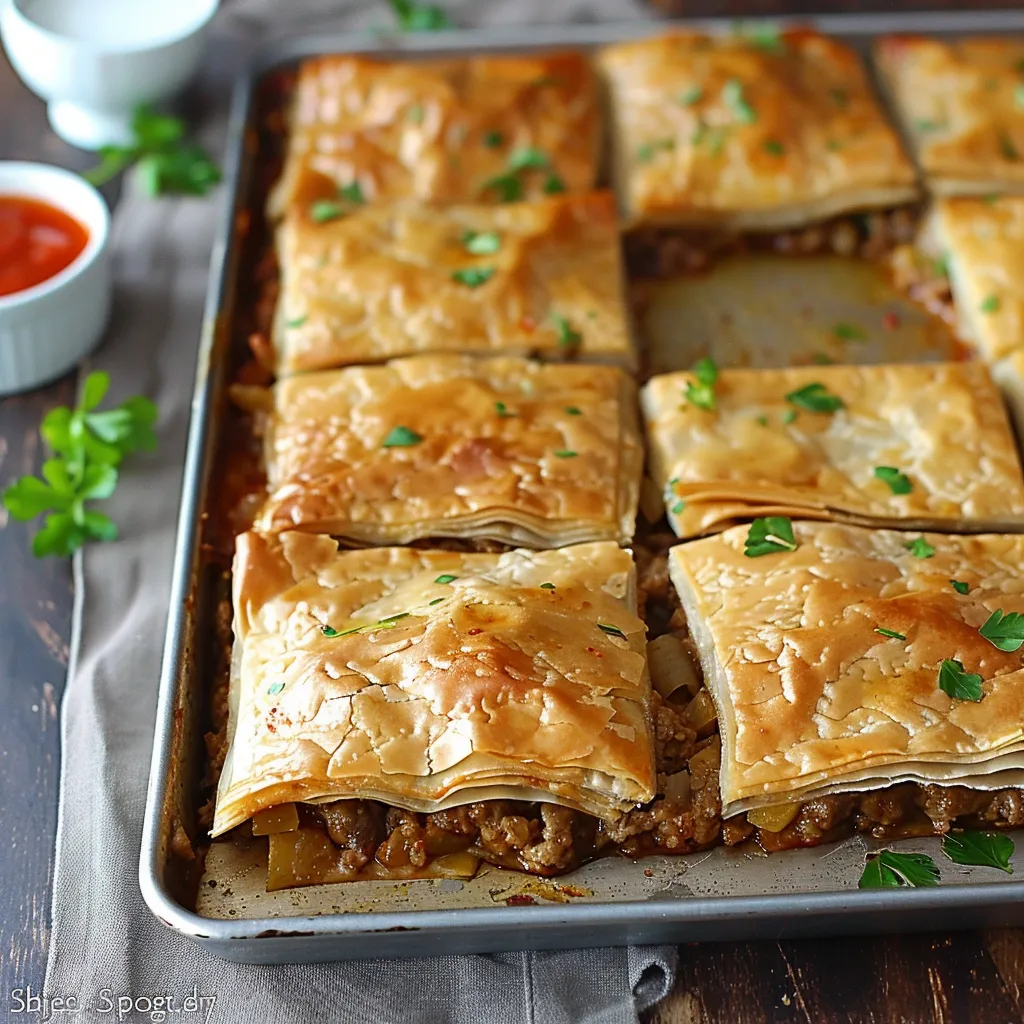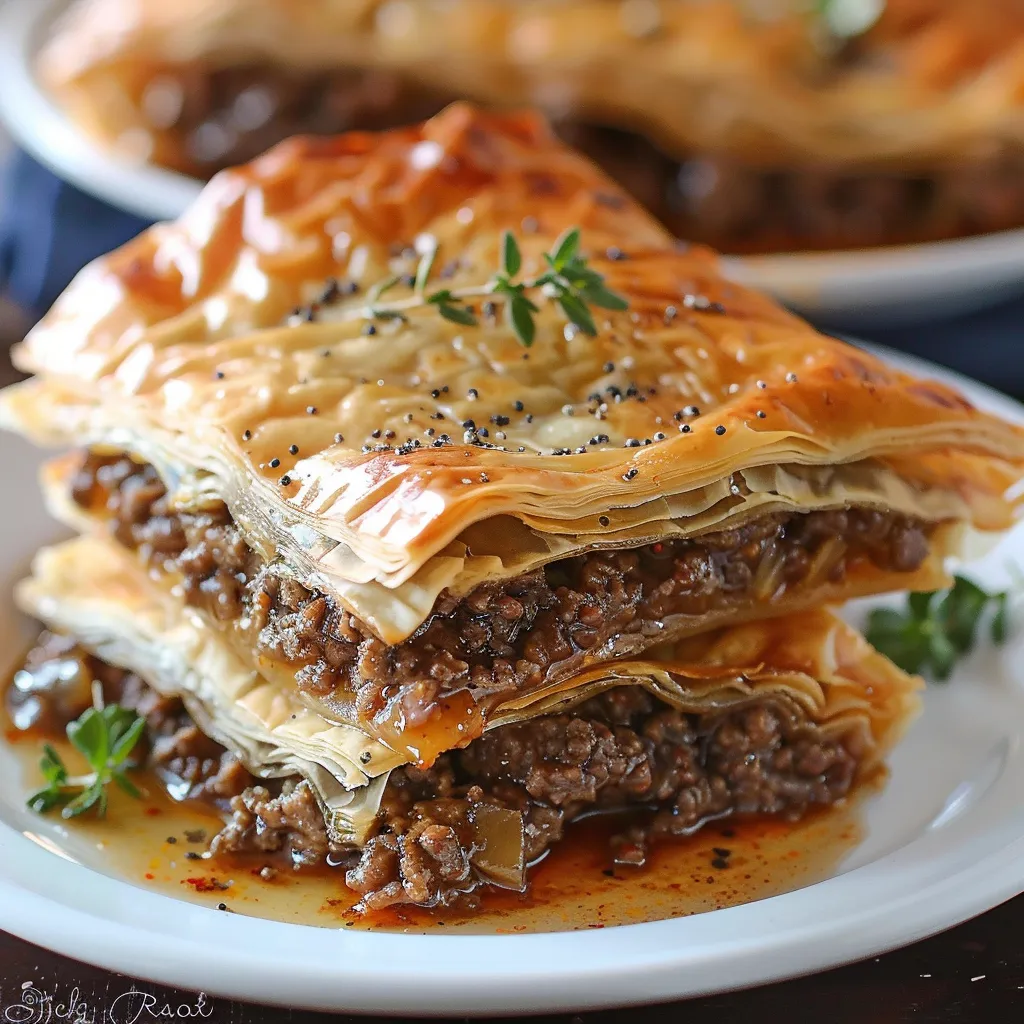 Pin to Favorites
Pin to Favorites
I still remember the first time I walked into my Egyptian friend's kitchen and encountered the intoxicating aroma of Egyptian Goulash baking in the oven. The scent of buttery phyllo crisping up around spiced beef created an atmosphere of warmth and anticipation that immediately made me feel at home. This traditional dish, with its delicate layers of tissue-thin pastry and savory filling, transforms humble ingredients into something truly magnificent – a testament to the ingenuity of Middle Eastern cuisine.
My neighbor Fatima taught me this recipe after I couldn't stop raving about it at her dinner party. She laughed as she showed me how simple it was to prepare, despite its impressive appearance. Now it's my go-to dish for gatherings where I want something that feels special without requiring constant attention in the kitchen.
Essential Ingredients and Selection Tips
- Phyllo Dough: Look for fresh phyllo in the refrigerated section rather than frozen, as it's less likely to tear.
- Ground Beef: Choose meat with approximately 15-20% fat content for the most flavorful result.
- Spice Blend: Includes allspice, cinnamon, and black pepper for aromatic depth.
- Ghee/Oil Mixture: A 50/50 mix of clarified butter and neutral oil ensures rich flavor and crisp texture.
 Pin to Favorites
Pin to Favorites
Detailed Cooking Instructions
- Prepare Your Workspace:
- Thaw phyllo dough according to package instructions. Preheat oven to 350°F (175°C). Mix 1/2 cup ghee with 1/2 cup neutral oil for brushing.
- Create a Flavorful Filling:
- Heat oil, sauté 1 diced onion until translucent. Add 1.5 lbs ground beef, cooking until browned. Season with 1 tsp allspice, 1/2 tsp cinnamon, 1 tsp black pepper, and 1.5 tsp salt.
- Master Phyllo Handling:
- Unroll phyllo and keep covered with plastic wrap and a slightly damp towel to prevent drying.
- Build Perfect Layers:
- Layer 10-12 sheets of phyllo in a greased 9x13 baking dish, brushing every second or third sheet with ghee-oil mixture.
- Add the Filling:
- Spread the beef mixture evenly over the phyllo base.
- Complete the Phyllo Top:
- Layer remaining phyllo sheets over the filling, brushing with ghee-oil mixture. Trim or tuck edges.
- Prepare the Binding Mixture:
- Whisk 2 eggs with 1 cup milk and 1/4 tsp salt.
- Apply the Egg-Milk Mixture:
- Make 3-4 slits in the top layers, then pour egg mixture evenly over.
- Bake to Perfection:
- Bake for 45-50 minutes, rotating halfway through, until golden brown.
- Rest and Serve:
- Let rest for 10-15 minutes before cutting into squares.
When I first attempted this recipe on my own, I was nervous about working with phyllo dough. I called Fatima in a panic when the sheets started tearing. She laughed and said, "This is not baklava – the beauty of goulash is in its rustic layers. Tears just add character!"
The Art of Spice Balancing
The classic combination of allspice, cinnamon, and black pepper creates warmth without overpowering the dish. Adding a pinch of cardamom or cumin can enhance complexity, while a touch of Aleppo pepper adds gentle heat.
Creating Perfect Phyllo Layers
Cold phyllo tears easily, so work with room-temperature sheets. Lightly brush with fat to prevent dry, papery layers. For an extra golden finish, brush the top with an egg yolk and milk mixture before baking.
Variations Worth Exploring
Try adding toasted pine nuts to the beef for richness or swapping the meat for a spinach and feta filling for a vegetarian version. Some versions include rice or caramelized onions for added texture.
Serving and Pairing Suggestions
Pair with a fresh tomato and cucumber salad or serve alongside vermicelli rice. For a mezze spread, serve with hummus, baba ganoush, and warm pita bread.
Making It Ahead: The Benefits of Time
Egyptian Goulash develops deeper flavor when made ahead. Store in the fridge overnight and reheat at 300°F for 15 minutes before serving.
The first time I served Egyptian Goulash at a dinner party, my friend's Egyptian father smiled and said, "This tastes like home." That moment reminded me how food connects us to tradition and shared experiences.
Final Thoughts
Egyptian Goulash exemplifies Middle Eastern cuisine’s brilliance in transforming simple ingredients into something extraordinary. Each time I make it, I’m reminded of Fatima’s kitchen and how food bridges cultures and traditions.
 Pin to Favorites
Pin to Favorites
Frequently Asked Questions
- → Can I prepare this Egyptian Goulash ahead of time?
- Yes, you can assemble the entire dish a day ahead and refrigerate it covered with plastic wrap. Remove from the refrigerator 30 minutes before baking to allow it to come to room temperature. You can also prepare just the meat filling 2-3 days in advance and store it in the refrigerator until you're ready to assemble.
- → How do I prevent the phyllo dough from drying out while assembling?
- Phyllo dough dries out quickly when exposed to air. Keep the sheets you're not currently using covered with a slightly damp kitchen towel while working. Work efficiently but don't rush - the key is to keep the unused phyllo covered at all times.
- → Can I freeze this phyllo meat pie?
- Yes, you can freeze it either before or after baking. If freezing before baking, assemble the pie completely but don't add the milk-egg mixture. Wrap tightly and freeze for up to 3 months. Thaw overnight in the refrigerator, then add the milk-egg mixture before baking. If freezing after baking, allow it to cool completely, wrap well, and freeze for up to 2 months.
- → What can I substitute for ground beef in this recipe?
- Ground lamb makes an excellent traditional substitute and pairs beautifully with the spices. For lighter options, try ground turkey or chicken, though you may want to add a tablespoon of olive oil to prevent dryness. For a vegetarian version, a mixture of finely chopped mushrooms, walnuts, and cooked lentils can mimic the texture of ground meat.
- → What's the difference between Egyptian Goulash and Hungarian Goulash?
- Despite sharing a name, these dishes are entirely different. Hungarian Goulash is a stew made with meat, vegetables, and paprika. Egyptian Goulash (also called Gullash) is a phyllo pastry dish with spiced meat filling. The name confusion likely came from Ottoman influence across both regions, with local adaptations creating distinct dishes.
